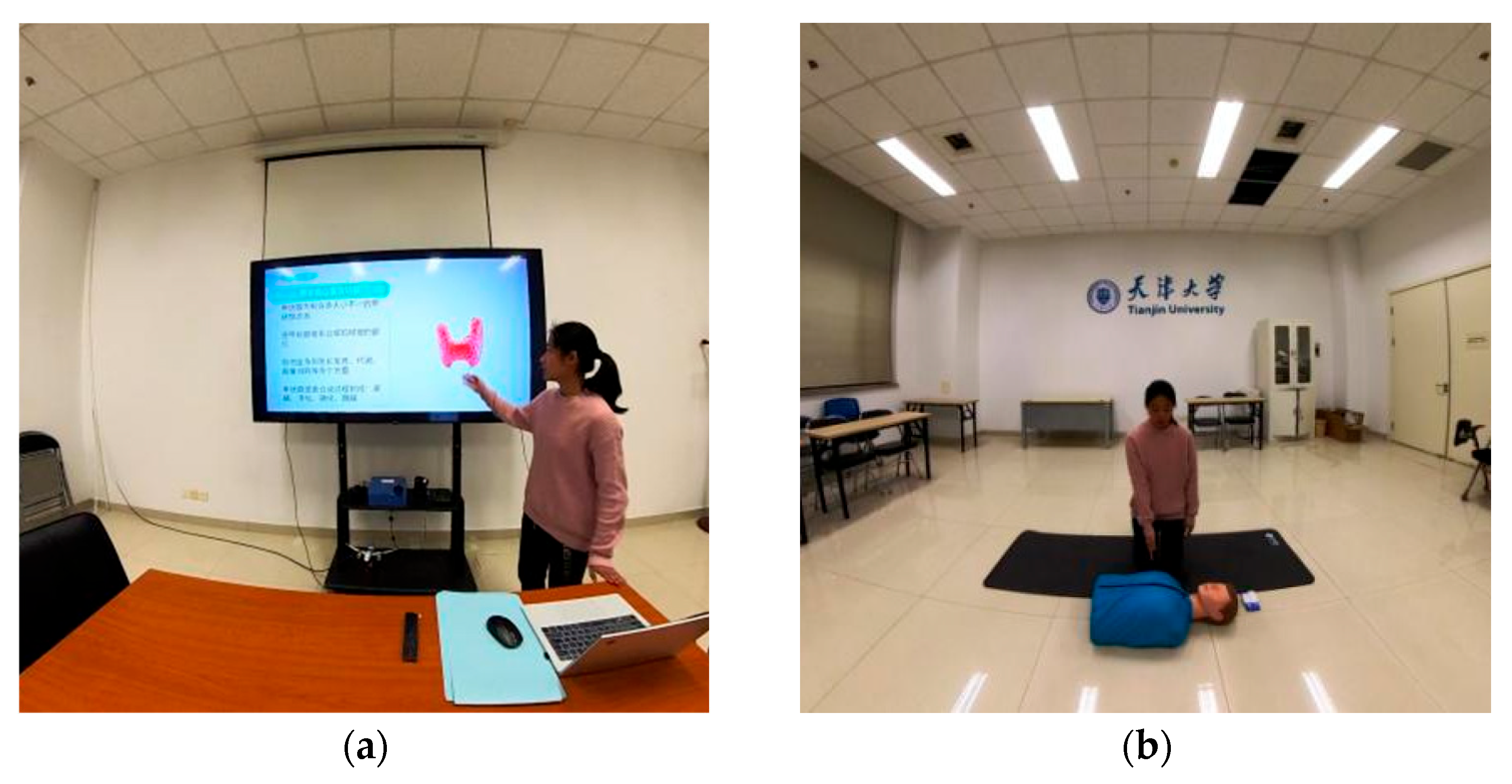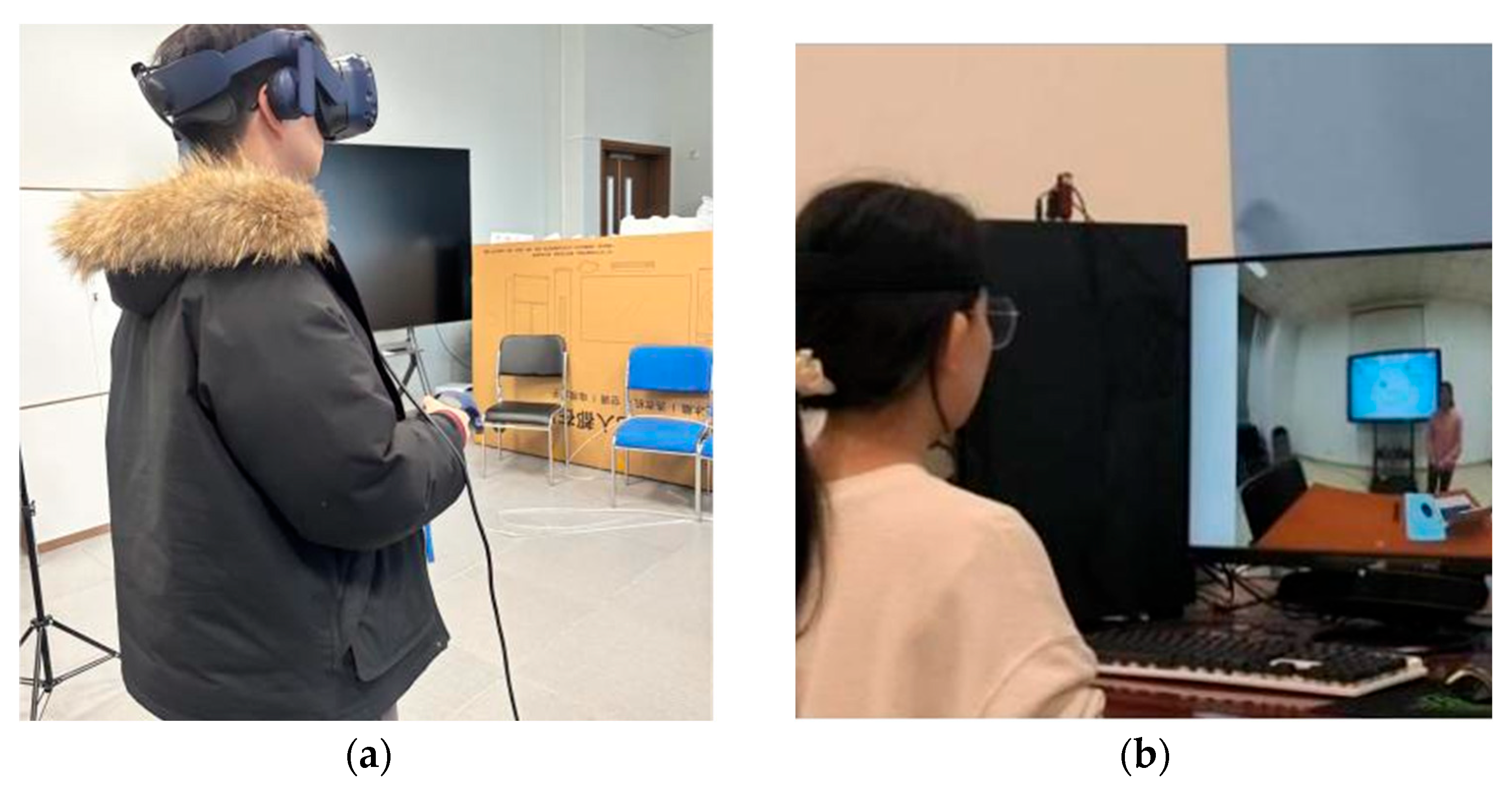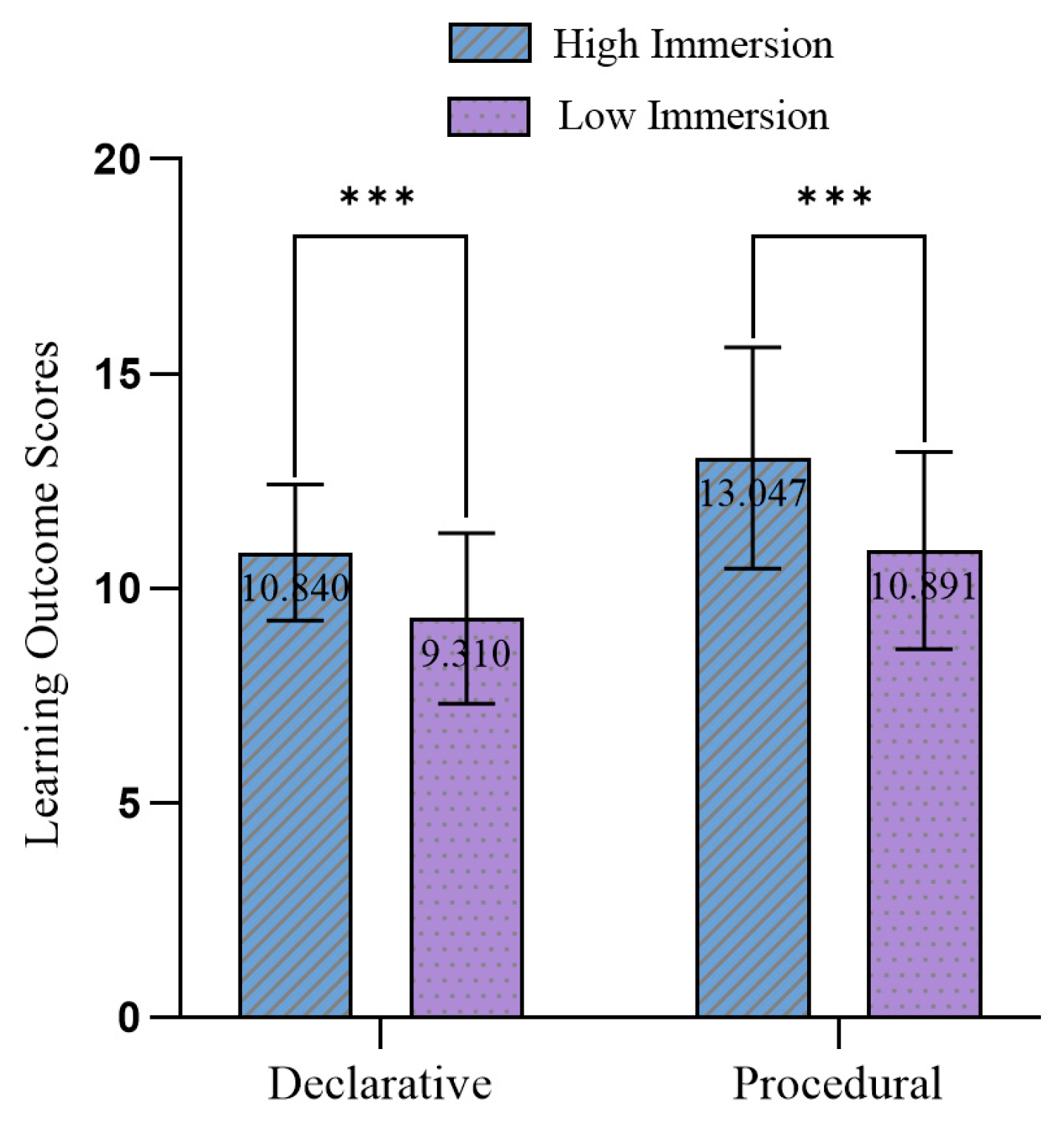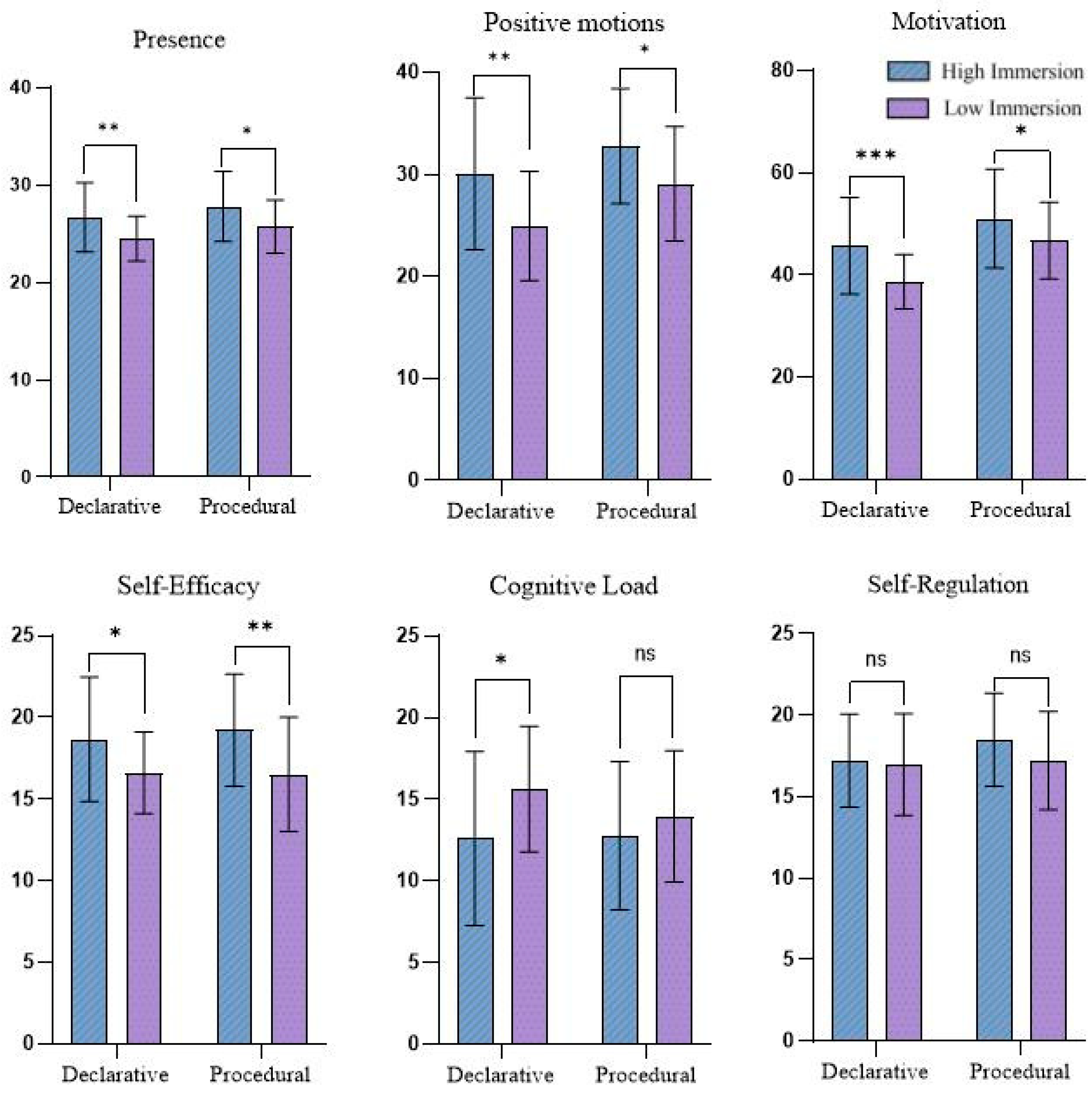The Impact of Virtual Reality Immersion on Learning Outcomes: A Comparative Study of Declarative and Procedural Knowledge Acquisition
Abstract
1. Introduction
2. Literature Review and Hypotheses
2.1. The Impact of VR Immersion on Learning Effectiveness
2.2. Learning of Declarative and Procedural Knowledge in VR
2.3. Cognitive and Affective Factors of Immersive Learning
3. Materials and Method
3.1. Research Design
3.2. Participants
3.3. Learning Materials
3.4. Setting and Apparatus
3.5. Measurement
3.5.1. Basic Information and Prior Knowledge Questionnaire
3.5.2. Learning Outcome Tests
3.5.3. Scales
3.6. Procedure
4. Results
4.1. Differences in Learning Outcomes Between Groups
4.2. Differences in Cognitive and Affective Factors Between Groups
5. Discussion
5.1. Enhanced Immersion Significantly Improves Learning Effectiveness for Both Declarative and Procedural Knowledge
5.2. Enhanced Immersion Significantly Improves Affective Experiences but Has Limited Impact on Cognition
6. Conclusions and Limitations
Author Contributions
Funding
Institutional Review Board Statement
Informed Consent Statement
Data Availability Statement
Acknowledgments
Conflicts of Interest
References
- Alaker, M., Wynn, G. R., & Arulampalam, T. (2016). Virtual reality training in laparoscopic surgery: A systematic review & meta-analysis. International Journal of Surgery, 29, 85–94. [Google Scholar] [CrossRef]
- Alhalabi, W. S. (2016). Virtual reality systems enhance students’ achievements in engineering education. Behaviour & Information Technology, 35(11), 919–925. [Google Scholar] [CrossRef]
- Anderson, J. R. (1982). Acquisition of cognitive skill. Psychological Review, 89, 369–406. [Google Scholar] [CrossRef]
- Araiza-Alba, P., Keane, T., Chen, W. S., & Kaufman, J. (2021). Immersive virtual reality as a tool to learn problem-solving skills. Computers & Education, 164(2), 104121. [Google Scholar] [CrossRef]
- Artino, A. R., Jr., & McCoach, D. B. (2008). Development and initial validation of the online learning value and self-efficacy scale. Journal of Educational Computing Research, 38(3), 279–303. [Google Scholar] [CrossRef]
- Bagher, M. M., Sajjadi, P., Carr, J., Femina, P. L., & Klippel, A. (2020, June 21–25). Fostering penetrative thinking in geosciences through immersive experiences: A case study in visualizing earthquake locations in 3D. 2020 6th International Conference of the Immersive Learning Research Network (iLRN), San Luis Obispo, CA, USA. [Google Scholar] [CrossRef]
- Bowman, D. A., & Mcmahan, R. P. (2007). Virtual reality: How much immersion is enough? Computer, 40(7), 36–43. [Google Scholar] [CrossRef]
- Broadbent, J., Panadero, E., Lodge, J. M., & Fuller-Tyszkiewicz, M. (2023). The self-regulation for learning online (SRL-O) questionnaire. Metacognition and Learning, 18(1), 135–163. [Google Scholar] [CrossRef]
- Buttussi, F., & Chittaro, L. (2018). Effects of different types of virtual reality display on presence and learning in a safety training scenario. IEEE Transactions on Visualization & Computer Graphics, 24(2), 1063–1076. [Google Scholar] [CrossRef]
- Calvert, J., & Abadia, R. (2020). Impact of immersing university and high school students in educational linear narratives using virtual reality technology. Computers & Education, 159, 104005. [Google Scholar] [CrossRef]
- Carassa, A., Geminiani, G., Morganti, F., & Varotto, D. (2002). Active and passive spatial learning in a complex virtual environment: The effect of efficient exploration. Cognitive Processing, 3(4), 65–81. Available online: https://www.researchgate.net/publication/228725774_Active_and_passive_spatial_learning_in_a_complex_virtual_environment_The_effect_of_efficient_exploration (accessed on 12 August 2025).
- Cohen, J. (1988). Statistical power analysis for the behavioral sciences (2nd ed.). Lawrence Erlbaum Associates. [Google Scholar]
- Combalia, A., Sanchez-Vives, M. V., & Donegan, T. (2024). Immersive virtual reality in orthopaedics—A narrative review. International Orthopaedics, 48(1), 21–30. [Google Scholar] [CrossRef] [PubMed]
- Cummings, J. J., & Bailenson, J. N. (2015). How immersive is enough? A meta-analysis of the effect of immersive technology on user presence. Media Psychology, 19, 272–309. [Google Scholar] [CrossRef]
- Delgado, C., & Mayer, R. (2025). Incorporating a generative learning activity during learning a procedural skill in immersive virtual reality. Journal of Educational Computing Research, 63, 930–953. [Google Scholar] [CrossRef]
- Elena, O. R., Janaina, F. C., Manuel, C., Concepción Castellanos, M., Chicchi, G. I. A., & Mariano, A. (2018). Mobile virtual reality as an educational platform: A pilot study on the impact of immersion and positive emotion induction in the learning process. Eurasia Journal of Mathematics Science & Technology Education, 14(6), 2045–2057. [Google Scholar] [CrossRef]
- Faul, F., Erdfelder, E., Buchner, A., & Lang, A.-G. (2009). Statistical power analyses using G* power 3.1: Tests for correlation and regression analyses. Behavior Research Methods, 41, 1149–1160. [Google Scholar] [CrossRef]
- Freude, H., Ressing, C., Müller, M., Niehaves, B., & Knop, M. (2020, January 7–10). Agency and body ownership in immersive virtual reality environments: A laboratory study. 53rd Hawaii International Conference on System Sciences, Maui, HI, USA. [Google Scholar] [CrossRef]
- Guerra-Tamez, C. R. (2023). The Impact of immersion through virtual reality in the learning experiences of art and design students: The mediating effect of the flow experience. Education Sciences, 13(2), 185. [Google Scholar] [CrossRef]
- Hong, J., Pi, Z., & Yang, J. (2018). Learning declarative and procedural knowledge via video lectures: Cognitive load and learning effectiveness. Innovations in Education & Teaching International, 55(1), 74–81. [Google Scholar] [CrossRef]
- Isen, A. M., & Reeve, J. (2005). The influence of positive affect on intrinsic and extrinsic motivation: Facilitating enjoyment of play, responsible work behavior, and self-control. Motivation & Emotion, 29(4), 295–323. [Google Scholar] [CrossRef]
- Kahneman, D. (1973). Attention and effort. Prentice-Hall. [Google Scholar]
- Karabiyik, U., Mousas, C., Sirota, D., Iwai, T., & Akdere, M. (2019). A virtual reality framework for training incident first responders and digital forensic investigators. In G. Bebis, R. Boyle, B. Parvin, D. Koracin, D. Ushizima, S. Chai, S. Sueda, X. Lin, A. Lu, D. Thalmann, C. Wang, & P. Xu (Eds.), Advances in visual computing: 14th international symposium on visual computing. Springer. [Google Scholar] [CrossRef]
- Kim, K., Rosenthal, M. Z., Zielinski, D. J., & Brady, R. B. (2014). Effects of virtual environment platforms on emotional responses. Computer Methods and Programs in Biomedicine, 113(3), 882–893. [Google Scholar] [CrossRef]
- Kim, T., & Biocca, F. (1997). Telepresence via television: Two dimensions of telepresence may have different connections to memory and persuasion. Journal of Computer-Mediated Communication, 3(2), JCMC325. [Google Scholar] [CrossRef]
- Klingenberg, S., Bosse, R., Mayer, R. E., & Makransky, G. (2024). Does embodiment in virtual reality boost learning transfer? Testing an immersion-interactivity framework. Educational Psychology Review, 36(4), 116. [Google Scholar] [CrossRef]
- Klingenberg, S., Jørgensen, M. L. M., Dandanell, G., Skriver, K., Mottelson, A., & Makransky, G. (2020). Investigating the effect of teaching as a generative learning strategy when learning through desktop and immersive VR: A media and methods experiment. British Journal of Educational Technology, 51(6), 2115–2138. [Google Scholar] [CrossRef]
- Kozhevnikov, M., Gurlitt, J., & Kozhevnikov, M. (2013). Learning relative motion concepts in immersive and non-immersive virtual environments. Journal of Science Education & Technology, 22(6), 952–962. [Google Scholar] [CrossRef]
- LaBar, K. S., & Cabeza, R. (2006). Cognitive neuroscience of emotional memory. Nature Reviews Neuroscience, 7(1), 54–64. [Google Scholar] [CrossRef]
- Liu, R., Wang, L., Koszalka, T. A., & Wan, K. (2022). Effects of immersive virtual reality classrooms on students’ academic achievement, motivation and cognitive load in science lessons. Journal of Computer Assisted Learning, 38(5), 1422–1433. [Google Scholar] [CrossRef]
- Lovreglio, R., Duan, X., Rahouti, A., Phipps, R., & Nilsson, D. (2021). Comparing the effectiveness of fire extinguisher virtual reality and video training. Virtual Reality, 25(1), 133–145. [Google Scholar] [CrossRef]
- Lui, M., Mcewen, R., & Mullally, M. (2020). Immersive virtual reality for supporting complex scientific knowledge: Augmenting our understanding with physiological monitoring. British Journal of Educational Technology, 51(6), 2180–2198. [Google Scholar] [CrossRef]
- Magner, U., Schwonke, R., Aleven, V., Popescu, O., & Renkl, A. (2014). Triggering situational interest by decorative illustrations both fosters and hinders learning in computer-based learning environments. Learning and Instruction, 29, 141–152. [Google Scholar] [CrossRef]
- Makransky, G. (2021). The immersion principle in multimedia learning. In R. E. Mayer, & L. Fiorella (Eds.), The Cambridge handbook of multimedia learning (3rd ed., pp. 296–302). Cambridge University Press. [Google Scholar]
- Makransky, G., Andreasen, N. K., Baceviciute, S., & Mayer, R. E. (2021). Immersive virtual reality increases liking but not learning with a science simulation and generative learning strategies promote learning in immersive virtual reality. Journal of Educational Psychology, 113(4), 719–735. [Google Scholar] [CrossRef]
- Makransky, G., & Lilleholt, L. (2018). A structural equation modeling investigation of the emotional value of immersive virtual reality in education. Educational Technology Research and Development, 66(5), 1141–1164. [Google Scholar] [CrossRef]
- Makransky, G., & Mayer, R. E. (2022). Benefits of taking a virtual field trip in immersive virtual reality: Evidence for the immersion principle in multimedia learning. Educational Psychology Review, 34, 1771–1798. [Google Scholar] [CrossRef] [PubMed]
- Makransky, G., & Petersen, G. B. (2021). The Cognitive Affective Model of Immersive Learning (CAMIL): A theoretical research-based model of learning in immersive virtual reality. Educational Psychology Review, 33(3), 937–958. [Google Scholar] [CrossRef]
- Makransky, G., Terkildsen, T. S., & Mayer, R. E. (2019). Adding immersive virtual reality to a science lab simulation causes more presence but less learning. Learning and Instruction, 60, 225–236. [Google Scholar] [CrossRef]
- Mayer, R. E. (2020). Multimedia learning (3rd ed.). Cambridge University Press. [Google Scholar] [CrossRef]
- Mayer, R. E., & Anderson, R. B. (1991). Animations need narrations: An experimental test of a dual-coding hypothesis. Journal of Educational Psychology, 83(4), 484–490. [Google Scholar] [CrossRef]
- Mayer, R. E., Makransky, G., & Parong, J. (2023). The promise and pitfalls of learning in immersive virtual reality. International Journal of Human-Computer Interaction, 39(11), 2229–2238. [Google Scholar] [CrossRef]
- Mihelj, M., Novak, D., & Begu, S. (2014). Virtual reality technology and applications. Springer. [Google Scholar] [CrossRef]
- Moreno, R. (2006). Does the modality principle hold for different media? A test of the method-affects-learning hypothesis. Journal of Computer Assisted Learning, 22(3), 149–158. [Google Scholar] [CrossRef]
- Moreno, R., & Mayer, R. E. (2004). Personalized messages that promote science learning in virtual environments. Journal of Educational Psychology, 96(1), 165–173. [Google Scholar] [CrossRef]
- Ochs, M., Mestre, D., De Montcheuil, G., Pergandi, J. M., Saubesty, J., Lombardo, E., Francon, D., & Blache, P. (2019). Training doctors’ social skills to break bad news: Evaluation of the impact of virtual environment displays on the sense of presence. Journal on Multimodal User Interfaces, 13(1), 41–51. [Google Scholar] [CrossRef]
- Paas, F. G. W. C. (1992). Training strategies for attaining transfer of problem-solving skill in statistics: A cognitive-load approach. Journal of Educational Psychology, 84(4), 429–434. [Google Scholar] [CrossRef]
- Parong, J., & Mayer, R. E. (2018). Learning science in immersive virtual reality. Journal of Educational Psychology, 110(6), 785–797. [Google Scholar] [CrossRef]
- Parong, J., & Mayer, R. E. (2021). Learning about history in immersive virtual reality: Does immersion facilitate learning? Educational Technology Research and Development, 69, 1433–1451. [Google Scholar] [CrossRef]
- Passig, D., Tzuriel, D., & Eshel-Kedmi, G. (2016). Improving children’s cognitive modifiability by dynamic assessment in 3D immersive virtual reality environments. Computers & Education, 95(4), 296–308. [Google Scholar] [CrossRef]
- Petersen, G. B., Petkakis, G., & Makransky, G. (2022). A study of how immersion and interactivity drive VR learning. Computers & Education, 179, 104429. [Google Scholar] [CrossRef]
- Plancher, G., Tirard, A., Gyselinck, V., Nicolas, S., & Piolino, P. (2012). Using virtual reality to characterize episodic memory profiles in amnestic mild cognitive impairment and Alzheimer’s disease: Influence of active and passive encoding. Neuropsychologia, 50(5), 592–602. [Google Scholar] [CrossRef]
- Radianti, J., Majchrzak, T. A., Fromm, J., & Wohlgenannt, I. (2020). A systematic review of immersive virtual reality applications for higher education: Design elements, lessons learned, and research agenda. Computers & Education, 147, 103778. [Google Scholar] [CrossRef]
- Richards, D., & Taylor, M. (2015). A comparison of learning gains when using a 2D simulation tool versus a 3D virtual world: An experiment to find the right representation involving the Marginal Value Theorem. Computers & Education, 86, 157–171. [Google Scholar] [CrossRef]
- Schuchardt, P., & Bowman, D. A. (2007, November 5–7). The benefits of immersion for spatial understanding of complex underground cave systems. ACM Symposium on Virtual Reality Software & Technology (pp. 121–124), New York, NY, USA. [Google Scholar] [CrossRef]
- Slater, M., & Wilbur, S. (1997). A framework for immersive virtual environments (five): Speculations on the role of presence in virtual environments. Presence Teleoperators & Virtual Environments, 6(6), 603–616. [Google Scholar] [CrossRef]
- Sobocinski, M., Dever, D., Wiedbusch, M., Mubarak, F., Azevedo, R., & Järvelä, S. (2023). Capturing self-regulated learning processes in virtual reality: Causal sequencing of multimodal data. British Journal of Educational Technology, 55(4), 1486–1506. [Google Scholar] [CrossRef]
- Stepan, K., Zeiger, J., Hanchuk, S., Signore, A. D., Shrivastava, R., Govindaraj, S., & Iloreta, A. (2017). Immersive virtual reality as a teaching tool for neuroanatomy. International Forum of Allergy & Rhinology, 7(10), 1006–1013. [Google Scholar] [CrossRef]
- Sweller, J., van Merriënboer, J. J. G., & Paas, F. (2019). Cognitive architecture and instructional design: 20 years later. Educational Psychology Review, 31(2), 261–292. [Google Scholar] [CrossRef]
- Tulving, E., & Thomson, D. M. (1973). Encoding specificity and retrieval processes in episodic memory. Psychological Review, 80(5), 352–373. [Google Scholar] [CrossRef]
- Vergara, D., Extremera, J., Rubio, M. P., & Dávila, L. P. (2019). Meaningful learning through virtual reality learning environments: A case study in materials engineering. Applied Sciences, 9(21), 4625. [Google Scholar] [CrossRef]
- Watson, D., & Clark, L. A. (1994). The PANAS-X: Manual for the positive and negative affect schedule-expanded form. University of Iowa. Available online: https://www2.psychology.uiowa.edu/faculty/clark/panas-x.pdf (accessed on 12 September 2025).
- Webster, R. (2016). Declarative knowledge acquisition in immersive virtual learning environments. Interactive Learning Environments, 24, 1319–1333. [Google Scholar] [CrossRef]
- Wilkerson, W., Avstreih, D., Gruppen, L., Beier, K. P., & Woolliscroft, J. (2008). Using immersive simulation for training first responders for mass casualty incidents. Academic Emergency Medicine, 15(11), 1152–1159. [Google Scholar] [CrossRef]
- Witmer, B. G., & Singer, M. J. (1998). Measuring presence in virtual environments: A presence questionnaire. Presence: Teleoperators & Virtual Environments, 7(3), 225–240. [Google Scholar] [CrossRef]
- Woo, Y. S., Jang, K. M., Nam, S. G., Kwon, M., & Lim, H. K. (2023). Recovery time from VR sickness due to susceptibility: Objective and quantitative evaluation using electroencephalography. Heliyon, 9(4), e14792. [Google Scholar] [CrossRef]
- Zimmerman, B. J. (2002). Becoming a self-regulated learner: An overview. Theory into Practice, 41(2), 64–70. [Google Scholar] [CrossRef]




| Variable | Category | Count | Percent (%) |
|---|---|---|---|
| Gender | Male | 21 | 32.8 |
| Female | 43 | 67.2 | |
| Educational level | Undergraduate | 19 | 29.7 |
| Master’s student | 42 | 65.6 | |
| Doctorate student | 3 | 4.7 | |
| Major category | Science, Technology, Engineering, and Mathematics (STEM) | 35 | 54.7 |
| Humanities and Social Sciences (HSS) | 29 | 45.3 |
| Variable | M | SD | t | df | p |
|---|---|---|---|---|---|
| Declarative knowledge | 3.401 | 62 | 0.001 *** | ||
| High Immersion | 10.84 | 1.59 | |||
| Low Immersion | 9.31 | 1.99 | |||
| Procedural knowledge | 3.53 | 62 | 0.001 *** | ||
| High Immersion | 13.05 | 2.58 | |||
| Low Immersion | 10.89 | 2.30 |
| Knowledge Type | Variable | M | SD | t | df | p |
|---|---|---|---|---|---|---|
| Declarative | Presence | 2.972 | 62 | 0.004 ** | ||
| High Immersion | 26.69 | 3.54 | ||||
| Low Immersion | 24.47 | 2.30 | ||||
| Positive emotions | 3.167 | 62 | 0.002 ** | |||
| High Immersion | 30.06 | 7.43 | ||||
| Low Immersion | 24.94 | 5.35 | ||||
| Motivation | 3.674 | 62 | 0.001 *** | |||
| High Immersion | 45.72 | 9.48 | ||||
| Low Immersion | 38.66 | 5.33 | ||||
| Self-Efficacy | 2.558 | 62 | 0.013 * | |||
| High Immersion | 18.66 | 3.82 | ||||
| Low Immersion | 16.59 | 2.49 | ||||
| Cognitive Load | −2.609 | 62 | 0.012 * | |||
| High Immersion | 12.59 | 5.33 | ||||
| Low Immersion | 15.63 | 3.84 | ||||
| Self-Regulation | 0.336 | 62 | 0.738 | |||
| High Immersion | 17.22 | 2.84 | ||||
| Low Immersion | 16.97 | 3.11 | ||||
| Procedural | Presence | 2.58 | 62 | 0.012 * | ||
| High Immersion | 27.78 | 3.61 | ||||
| Low Immersion | 25.72 | 2.73 | ||||
| Positive emotions | 2.626 | 62 | 0.011 * | |||
| High Immersion | 32.78 | 5.62 | ||||
| Low Immersion | 29.09 | 5.61 | ||||
| Motivation | 2.006 | 62 | 0.049 * | |||
| High Immersion | 51.03 | 9.67 | ||||
| Low Immersion | 46.7 | 7.51 | ||||
| Self-Efficacy | 3.14 | 62 | 0.003 ** | |||
| High Immersion | 19.22 | 3.43 | ||||
| Low Immersion | 16.5 | 3.49 | ||||
| Cognitive Load | −1.11 | 62 | 0.271 | |||
| High Immersion | 12.75 | 4.53 | ||||
| Low Immersion | 13.94 | 4.02 | ||||
| Self-Regulation | 1.747 | 62 | 0.086 | |||
| High Immersion | 18.5 | 2.85 | ||||
| Low Immersion | 17.22 | 3.01 |
Disclaimer/Publisher’s Note: The statements, opinions and data contained in all publications are solely those of the individual author(s) and contributor(s) and not of MDPI and/or the editor(s). MDPI and/or the editor(s) disclaim responsibility for any injury to people or property resulting from any ideas, methods, instructions or products referred to in the content. |
© 2025 by the authors. Licensee MDPI, Basel, Switzerland. This article is an open access article distributed under the terms and conditions of the Creative Commons Attribution (CC BY) license (https://creativecommons.org/licenses/by/4.0/).
Share and Cite
Yu, N.; Shi, W.; Dong, W.; Kang, R. The Impact of Virtual Reality Immersion on Learning Outcomes: A Comparative Study of Declarative and Procedural Knowledge Acquisition. Behav. Sci. 2025, 15, 1322. https://doi.org/10.3390/bs15101322
Yu N, Shi W, Dong W, Kang R. The Impact of Virtual Reality Immersion on Learning Outcomes: A Comparative Study of Declarative and Procedural Knowledge Acquisition. Behavioral Sciences. 2025; 15(10):1322. https://doi.org/10.3390/bs15101322
Chicago/Turabian StyleYu, Nengbao, Wenya Shi, Wei Dong, and Renying Kang. 2025. "The Impact of Virtual Reality Immersion on Learning Outcomes: A Comparative Study of Declarative and Procedural Knowledge Acquisition" Behavioral Sciences 15, no. 10: 1322. https://doi.org/10.3390/bs15101322
APA StyleYu, N., Shi, W., Dong, W., & Kang, R. (2025). The Impact of Virtual Reality Immersion on Learning Outcomes: A Comparative Study of Declarative and Procedural Knowledge Acquisition. Behavioral Sciences, 15(10), 1322. https://doi.org/10.3390/bs15101322






